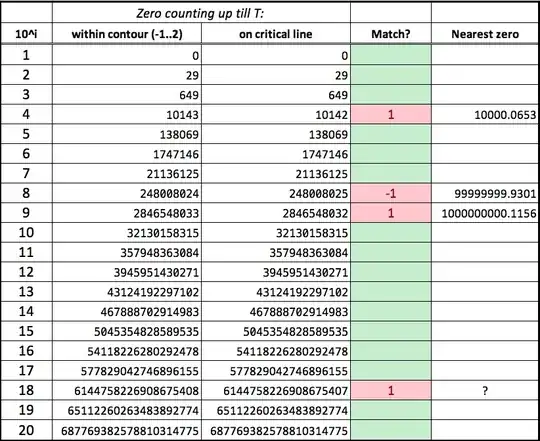It is well known that:
$$\frac{\zeta'(s)}{\zeta(s)} + \frac{\zeta'(1-s)}{\zeta(1-s)} = \ln(2\pi) + \frac{\pi}{2}\tan\left(\frac{\pi s}{2} \right)-\Psi(s)$$
where $\Psi(s)$ is the DiGamma function.
Surprisingly, integrating the LHS and the RHS along a vertical line in the complex plane gives different outcomes. The real parts are equal, however the imaginary parts differ. For example:
$$\int_{2}^{2+100 i} \bigg(\frac{\zeta'(s)}{\zeta(s)} + \frac{\zeta'(1-s)}{\zeta(1-s)}\bigg) ds = 7.1335966...+3.137700...i$$
whereas:
$$\int_{2}^{2+100 i} \bigg(\ln(2\pi) +\frac{\pi}{2}\tan(\frac{\pi s}{2})- \Psi(s)\bigg) ds = 7.1335966...+179.074673...i$$
Q1: Why is this the case? (note: I tried different CAS tools and all yield the same difference).
EDIT 1 (based on comments): it appears that only Maple evaluates the first integral as:
$$\ln(2)-\pi i +2\ln(\pi) +\ln\big(\zeta(-1-Ti)\big)-\ln\big(\zeta(2+Ti)\big)$$
which explains the difference reported above.
I also found that the difference could be exploited to (almost) establish the number of zeros of $\zeta(s)$ with an imaginary part $< T$ through the following formula:
$$\frac{1}{2\,\pi} \Im \bigg[ \int_{2}^{2+T i} \bigg(\ln(2\pi) +\frac{\pi}{2}\tan(\frac{\pi s}{2})- \Psi(s)\bigg) ds - \int_{2}^{2+T i} \bigg(\frac{\zeta'(s)}{\zeta(s)} + \frac{\zeta'(1-s)}{\zeta(1-s)}\bigg)ds \bigg]$$
which has the closed form expression:
$$N^*(T)=\frac{1}{2\,\pi} \bigg[\Im\big(\ln\Gamma(2+iT)\big) +\pi - T\ln(2\pi) + \arg\big(\zeta(2+iT)\big)-\arg\big(\zeta(-1-iT)\big)\bigg]$$
EDIT 2: $\ln\Gamma(2+iT)$ is the LogGamma-function (i.e. LogGamma[z] in Mathematica and lnGAMMA in Maple).
When I widen the contour $-1 < \sigma > 2$ the number of zeros increases and I believe this is due to the inclusion of real (non-trivial) zeros in the count.
However, when I compare the number of zeros from the 'contour' with the well known formula for counting zeros on the critical line of $\zeta(s)$ up to $T$, I get the following results:
EDIT 3: I am now allowed to include pictures.
The match between both counts seems pretty good, however occasionally could be off by $\pm 1$. This seems to occur when a non-trivial zero of $\zeta(s)$ lies very close to $T$. Therefore not sure whether I am actually counting the non-trivial zeros of $\zeta(s)$ or something 'close' to it.
Q2: Which zeros is $N^*(T)$ actually counting?
Q3: Could there be a way to select a $T$ that always gives the correct count for the zeros of $\zeta(s)$?
